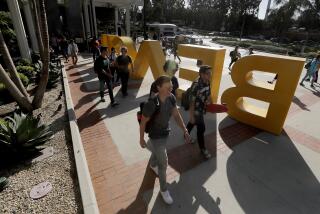Cal State wants to double its graduation rate by 2025

- Share via
California State University leaders have set some big goals for the next decade: to double the percentage of students who graduate in four years and improve graduation at an even higher rate for minorities and low-income students.
By 2025, the university system wants 40% of freshmen to graduate in four years, up from 19% now, and 45% of transfer students in two years, up from 31% now.
For the record:
5:00 p.m. Sept. 20, 2016A previous version of this article said individual campuses’ freshman four-year graduation rate goals ranged from 55% to 92%. The goals range from 30% to 71%.
Even though graduation rates have been increasing incrementally across the system in recent years, gaps based on race, income and first-generation college status still remain. By 2025, Cal State aims to reduce those gaps to zero, bringing disadvantaged students up to the same graduation rates as their peers.
Officials estimate that raising the graduation rates will cost $400 million to $500 million. If they succeed, about 500,000 more students will graduate by 2025 than if graduation rates remained as they are now.
There are goals to improve six-year freshman graduation rates and four-year transfer graduation rates, but the primary focus will be on getting students who start as freshmen out in four years and those who transfer out in two.
Gov. Jerry Brown has pushed the system to focus on getting more students through quickly.
Members of the CSU board of trustees’ education policy committee approved the new graduation goals Tuesday in Long Beach, and the entire board is expected to approve the goals Wednesday.
Cal State needs to determine graduation goals this week in order to receive $35 million in one-time state funding for 2016-17. After the trustees vote on the goals, the plan will go to the state Finance Department for approval.
The plan does not say what Cal State would do if the state did not fund the entire effort. It also does not yet set annual benchmarks for campuses to meet. That’s in part because of the rush to meet the deadline, said Jeff Gold, CSU’s assistant vice chancellor for student success and strategic initiatives. He said in an interview that he learned in July, when the state budget was finalized, that the goals would be due this month in order for the colleges to receive the $35 million.
Each of the 23 campuses has its own graduation goals, based on current rates, and has identified strategies to meet them. The goals range from 30% to 71% for freshman four-year graduation rates, and from 23% to 64% for two-year transfer graduation rates.
Strategies include encouraging more students to take a full course load, hiring additional faculty to teach high-demand “bottleneck” classes that many students need to graduate, and providing additional supports such as academic advisors and tutoring, Gold said.
The Cal State finance committee also discussed a preliminary calculation of what it might ask from the state for the 2017-18 school year: an additional $168.8 million that would include $75 million for the graduation initiative and pay for increased salary costs and facility upgrades.
Tuesday’s budget discussion was informational. Trustees will vote in November on how much to ask from the state.
If the state doesn’t provide enough funding, tuition increases may be an option, Steve Relyea, Cal State’s executive vice chancellor and chief financial officer, told board members Tuesday.
“Our No. 1 goal is to fill this gap with an investment by the state,” Relyea said. Still, he said the system would start the tuition-increase process just in case, because students must be consulted for input far in advance of any hike.
Trustees emphasized Tuesday that school officials need contingency plans in place in case they don’t get all the money they need.
“If we don’t get the money from the state,” trustee Steven Stepanek said, “please, we need to then be able to scale it back.”
Until now, Cal State campuses have been focusing on improving their six-year graduation rates. Switching to four-year rates will mean spending more money and targeting different students, said Cal State Fullerton President Mildred Garcia.
That means offering Pell grants for summer sessions, Garcia said, and finding the students who don’t need remedial courses and making sure they get the right guidance to plan the classes they need to graduate in four years.
At Fullerton, the goal is slightly higher than the system average: by 2025, the campus hopes to have 44% of freshmen graduate in four years, up from 22% now.
Reach Sonali Kohli at [email protected] or on Twitter @Sonali_Kohli.
More to Read
Sign up for Essential California
The most important California stories and recommendations in your inbox every morning.
You may occasionally receive promotional content from the Los Angeles Times.











